2338 people reached on FB page Lassi with Lavina
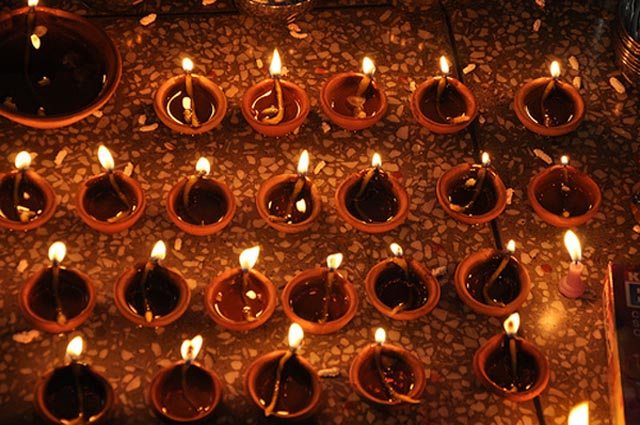
Durga Puja and Diwali Remembered
[dropcap]A[/dropcap]s a journalist, I’ve always been intrigued by the unique experiences, sights and sounds of individual lives, a billion stories waiting to be told. Immigrants who’ve traveled to a new country always have their idiosyncratic cache of memories, of a past which belongs only to themselves.
Some years back I had spoken with Sarbari Chowdhury, who migrated from Calcutta to the US many years ago, about the Durga Puja and Diwali celebrations in Phoenix, AZ. An engineer by training, she was raised in Jamshedpur and now works as a Senior Program Manager at Intel Corp. She and her husband Debasish have two children. In true Indian fashion, she is into many things, including reading and traveling, has published ‘Earthen Angels’, a book of short stories, and is a community organizer, active in the Bengali and Indian organizations.
I re-connected with her to chat about celebrations in the old country, and in the new. Times change, places change. Even the names of much loved places change – Calcutta is now Kolkata.
“Of course, I miss Kolkata, my home and my family during the festival season. Actually, my fondest memories of Durga Puja are the ones that I spent at my grandparents’ house,” she says.
“Back home, the month and a half leading up to Durga puja used to be a frenzy of shopping for new clothes and making savories and sweets. And then, I miss the aroma of agarbattis when I walked into our house during the pujas. I miss the garland of mango leaves that my mother hung outside our front door. I miss the two ‘mangal kalash’ she put at the front gate during Durga Puja. I miss the sound of the mike blaring the puja mantras from seven in the morning.”
How has Phoenix changed in the past few years and has she managed to recreate some of the old magic here?
“The Indian population has increased in Phoenix and with that there have definitely been a lot of changes,” she says. “The number of young people – children and teenagers – has grown and the perspective they bring to the celebrations is new and refreshing. Durga Puja, Diwali and the other eleven festivals – India has 13 festivals in 12 months – have all evolved to be much more colorful and diverse in Phoenix.”
Here in Sarbari Chowdhury’s words,
Durga Puja and Diwali Festivities,
Kolkatta memories and Phoenix realities:
[dropcap]T[/dropcap]he Indian community in Phoenix has evolved from being a smaller community of single young professionals to more a more mature and settled community. I mean, our contemporaries now have children and also the city has a lot more Indians.
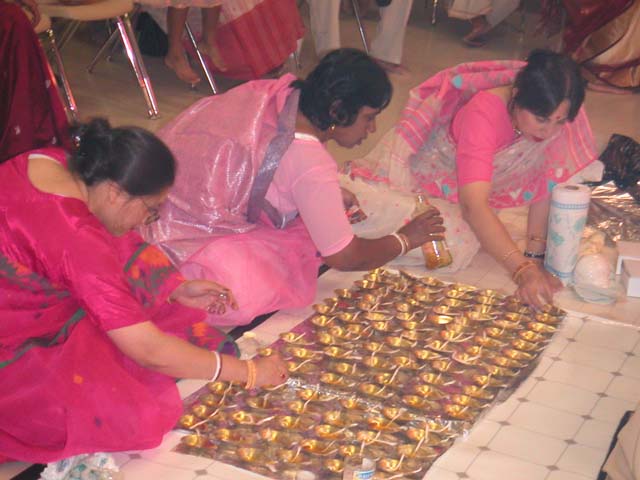
What this had done for the festivals is that the crowd is a lot more colorful and diverse. An example is the cultural events during the festivals – we now see very talented young second generation American children of Indian origin participating, and in many cases, leading these events. We also have more talent from India with the increase in the Indian population leading to more variety for us.
Also, our temples now have full time priests performing the rituals. Earlier, the puja rituals were usually performed by an amateur local Brahmin person, who by profession was an engineer, doctor or professor.
In addition, now Phoenix boasts at least five different temples. Earlier, there was just 1 temple and during the festivals if you went to the temple, you could be almost 100 percent sure of running into the entire community. Not so anymore. The community has grown, as have the venues for celebration.
Though our Durga Puja still remains a celebration for the community, by the community, of the community – earlier I knew at least 90 percent of the community – now no more than 60 percent. But again, with a larger community, comes more funds and as a result – in Phoenix we have fireworks displays during Diwali and a Ravan Dahan event at one of the temples.”

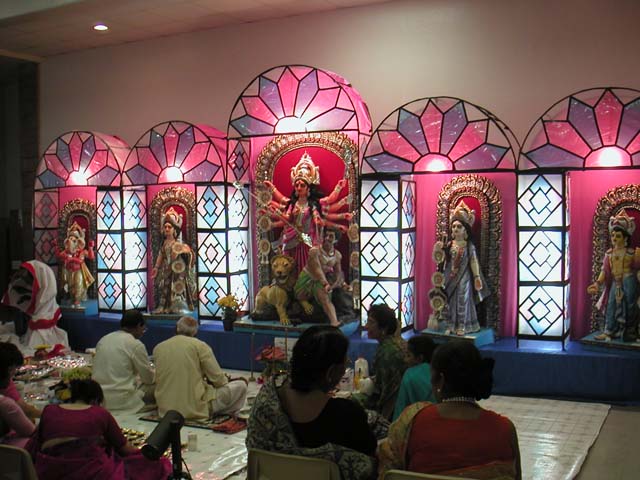
Durga Puja and Diwali – Past and Present
[dropcap]O[/dropcap]f course, I miss Kolkata, my home and my family during the festival season. Actually, my fondest memories of Durga Puja are the ones that I spent at my grandparents’ house.
Back home, the month and a half leading up to Durga puja used to be a frenzy of shopping for new clothes and making savories and sweets. And then, I miss the aroma of agarbattis when I walked into our house during the pujas. I miss the garland of mango leaves that my mother hung outside our front door. I miss the two ‘mangal kalash’ she put at the front gate during Durga Puja. I miss the sound of the mike blaring the puja mantras from seven in the morning.
I miss the ‘bhog’ of khichri and fried potatoes and kheer every afternoon for lunch. I miss visiting the numerous puja pandals – we visited all night – seven or eight of us, uncles, aunts, cousins packed into one car. I miss seeing the sindoor covered faces of my mother and grandmother when they returned from the puja pandal on Dusshera after the ritual of ‘sindoor khela’ – where married women bid the Goddess goodbye and apply sindoor on each other’s faces for fun.
I miss going from house to house in the neighborhood, touching the feet of the elders, asking for their blessing and eating mithai that they always offered – it’s a tradition – till we were ready to throw up!
But I have now found new rituals of my own for Durga Puja here in America. The weekends leading up to Durga Puja are spent in rehearsing for the community cultural event – both for the children and adults. The days are spent creating massive artwork for the Durga idol’s pandal. They are spent cooking for the community meals to be served during the celebrations.
On the days of the celebrations, the rituals of waking up early, fasting and going to help with the puja preparations have emerged. We are definitely blessed with enough friends here that now, we can reminisce about the Durga Pujas we left behind back home. And that kind of friendship and camaraderie is priceless too.
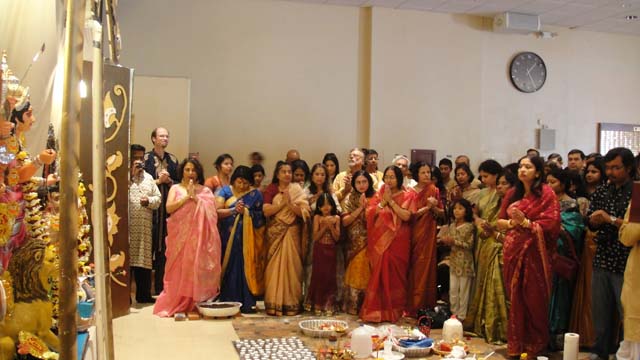
[dropcap]M[/dropcap]y children – Shilpika ,17 and Abhik, 14, really enjoy the festivals. I am amazed at how much importance they place on participating in the rituals. On the day before Diwali, our ritual is to place 14 ‘diyas’ or candles at the each of the doors of our house. If there are more than 14 doors then we focus on the doors leading outside the house; if there are less than 14 doors we double the candles at doors leading to the outside. The children enjoy the ritual of setting up the tray with the 14 candles and then going around the house placing then at the doors.
During Durga Puja, our ritual is to not eat any rice for lunch on ‘Asthami or the 8th day of the celebrations and feast on goat meat at dinner on Navami or the 9th day of the celebrations. The children follow that faithfully. They also wake up early on the celebration days and shower and dress in new clothes and fast for the ‘pushpnjali’ ritual, offering flowers to the deity while repeating mantras recited by the priest. They also very enthusiastically participate in the community cultural programs and Shilpika loves to plan, along with her other Bengali friends, what to wear on the various days of the event. It is fun to hear them planning their lehengas and saris and bangles and bindis.
They always make sure that they clear their calendars for the celebration weekends so they can attend the festivities! Next year Shilpika will be leaving for college – I do hope she finds a place to celebrate these festivals that have become part of her life.
Diwali and Durga Puja Sweets
Sarbari’s Kacha Golla – A Bengali Mithai
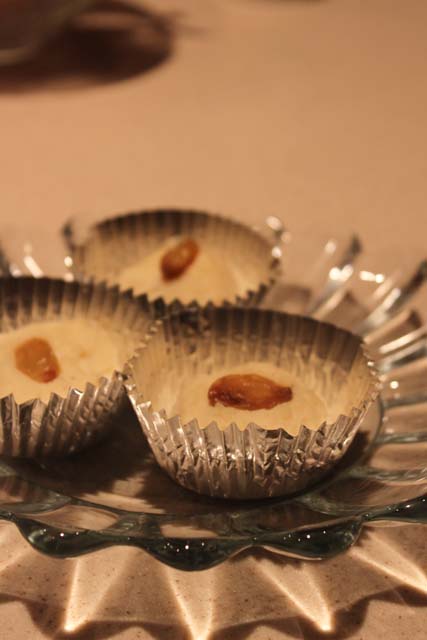
I typically buy most of my Diwali and Durga Puja sweets either from a local ‘Indian’ grocery store or from an Indian caterer. But there are a couple of items I make at home. The family’s favorites are Ras Malai and ‘Kacha Golla’ (a Bengali mithai). Both are very simple to make. But let me share the recipe for my ‘Kacha Golla’.
Kacha Golla
Ricotta cheese 32oz
Sugar 1/2 cup + 1 tablespoon
Cardamom powder 1/2 teaspoon
Kewra water 5-6 drops
Raisins 24
If raisins are very dry soak them in warm water for 10 mins and keep aside.
Pour the Ricotta cheese into a wok over medium heat and keep stirring it till most of the water has dried out. Add sugar and continue stirring making sure the cheese mixture does not get burnt. When the mixture is fairly dry and starts leaving the sides of the wok – take the wok off of the stove. Keep stirring for another 30 seconds and then allow the mixture to cool a little.
Once the mixture is cool enough to handle – pinch off table tennis ball size chunks and roll into ball shapes on your palms.
Top with a raisin each.
‘Kacha Golla’ is ready.
Related Article: Navratri – Goddess Power

1 Comment
Pingback: | Lassi With Lavina